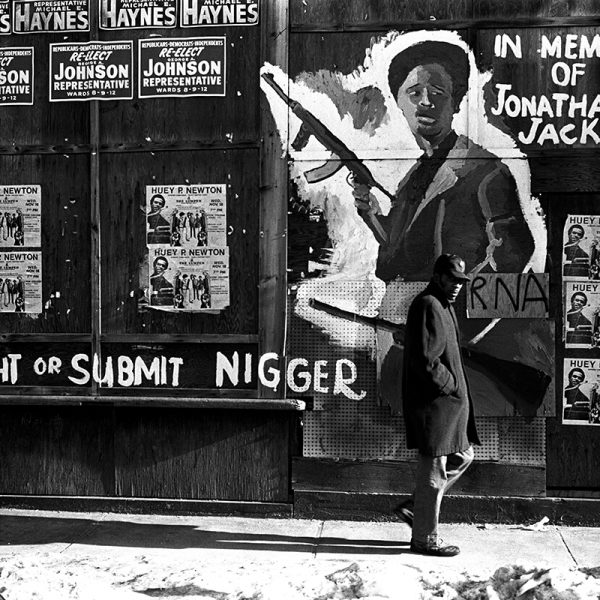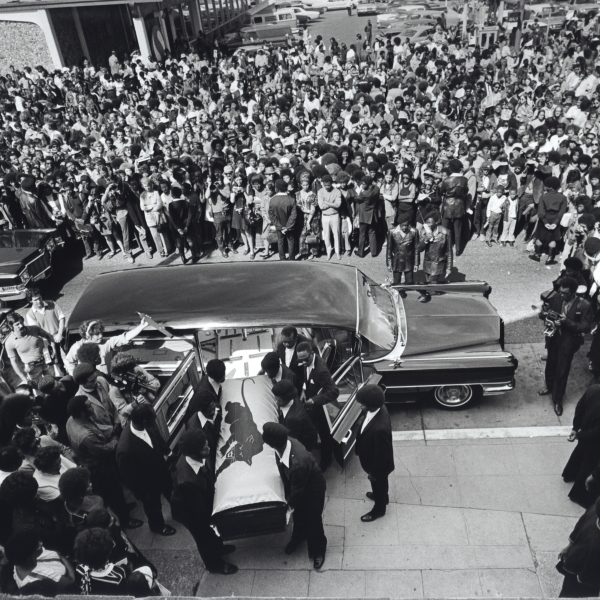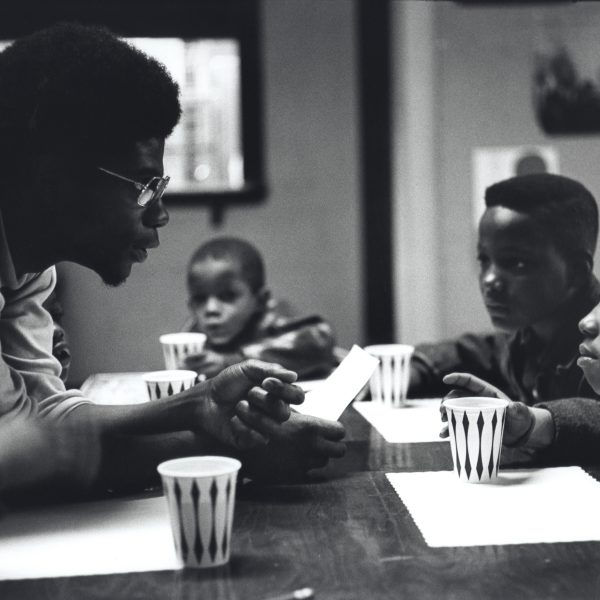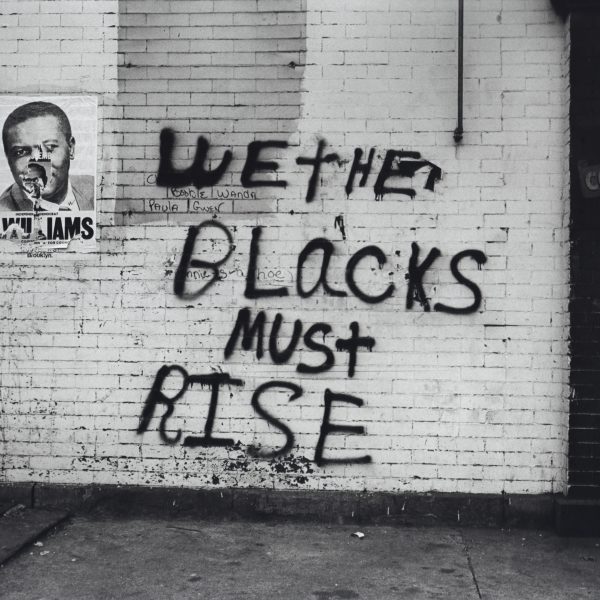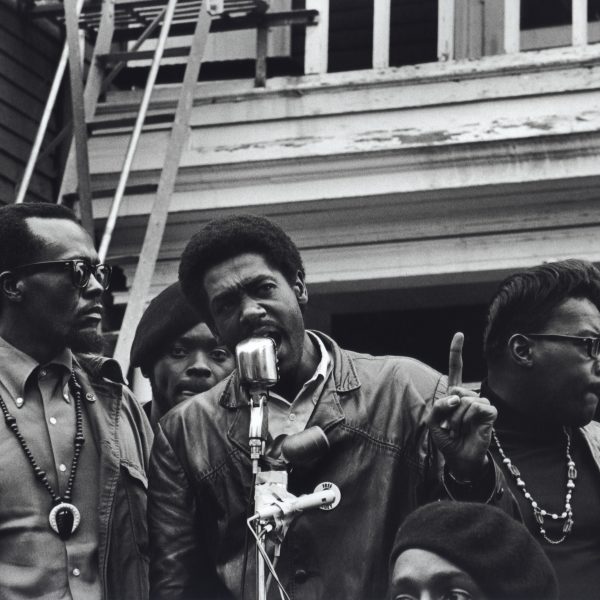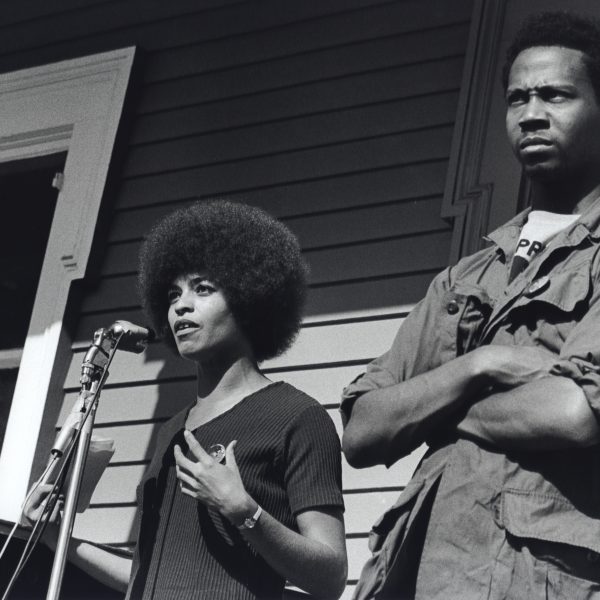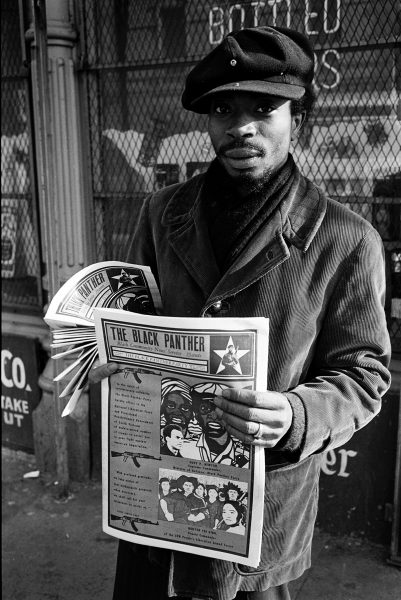Si intitola Reconsidering the Black Panthers Through Photos il pezzo a firma Maurice Berger apparso sul New York Times. Luce per i nostri occhi alla ricerca costante di bucare l’oscurità dei tempi. Foto bellissime narrano la storia delle Black Panthers e noi siamo particolarmente legati a questa storia perché tra i nostri ispiratori c’è proprio Emory Douglas, che troverete in foto, l’artista magnifico che ha realizzato lo spettacolare giornale delle Black Panthers. Con commozione e gioia, eccovi le foto di Stephen Shames, tratte dalla mostra Power to the people, presso la Steven Kasher Gallery in New York. E a seguire il testo del Nyt.
A black man helps an older African-American woman as she shops in an Oakland, Calif., supermarket. The image from 1972, by Stephen Shames, documents an initiative to protect the elderly in a crime-ridden neighborhood. It doesn’t just show community activism, it also challenges lurid media stereotypes about the organization responsible for the initiative: the Black Panther Party.
This is one of many photographs in an important new book by Mr. Shames and Bobby Seale, “Power to the People: The World of the Black Panthers” (Abrams), that help us to better understand one of the most innovative, if controversial, American movements for racial equality and justice. An accompanying exhibition of Mr. Shames’s Panther photographs opens this month at the Steven Kasher Gallery in New York.
Published on the 50th anniversary of the party’s founding, “Power to the People” constitutes an impressionistic visual and oral history of the Panthers. It combines in-depth commentary by Mr. Seale, a major figure within the Panthers; the photographs and observations of Mr. Shames, the group’s principal visual chronicler; excerpts of interviews Mr. Shames conducted with party leaders — including Kathleen Cleaver, Emory Douglas, Elbert (Big Man) Howard, Ericka Huggins, Billy X Jennings and Jamal Joseph — as well as the words of Huey P. Newton and Eldridge Cleaver.
Mr. Shames was a student at the University of California, Berkeley, when he became active in politics. He met Mr. Seale and Mr. Newton in San Francisco during the Spring Mobilization to End the War in Vietnam six months after they founded the Black Panther Party for Self Defense in October 1966.
“I started hanging out with the Panthers, attending their rallies,” Mr. Shames recalled in the text. “Bobby Seale became my mentor and friend. … I was granted incredible access. Over the next seven years, culminating in Bobby Seale’s 1973 campaign for mayor of Oakland, I documented this group of young men and women, who were at the forefront of the Black Power movement and who became the vanguard of the revolution that was sweeping America.”
The aims of the Black Panther Party were diverse and complex. On one level, the group advocated armed resistance against police misconduct and abuse, as well as a revolution to achieve the racial equality and justice that it felt the nonviolent civil rights movement had failed to achieve. As the party gained momentum, J. Edgar Hoover, director of the F.B.I., deemed it “the greatest threat to the internal security of the country.” Vowing that 1969 would be the last year of the Panthers’ existence, Hoover made it a principal target of the bureau’s Cointelpro initiative, established in the 1950s to monitor, infiltrate and discredit radical political organizations.

But the movement endured, in part because its objectives went far beyond armed self-defense and insurrection. To some extent stymied by the 1967 Mulford Act — which repealed the right to publicly bear firearms in California, a bill created largely in response to Panther members who were conducting armed patrols of Oakland neighborhoods — the party increasingly emphasized community-based activism, voter registration drives and more than 60 “survival programs.” Those programs included free medical, eye and dental care, legal aid, food cooperatives, employment referral, plumbing, pest control and home maintenance programs, screening for sickle cell anemia, a child development center and a well-regarded school.
Granted, among such a group of strong-willed leaders with a particular vision, “the Panthers suffered from the factionalism, disorganization and personality cults that so often afflict oppositional movements,” wrote the Times critic A. O. Scott in his review of the 2015 documentary “The Black Panthers: Vanguard of the Revolution.”
But Mr. Shames’s pictures affirmed the movement’s complexity, countering an unrelenting stream of mainstream images of menacing, gun-toting men, women and children. If some in the news media viewed the party as an influential force for black autonomy, others saw it as a criminal organization. “Power to the People” offers a relatively nuanced view of a militant national organization that advocated insurrection and armed resistance, but also fought for empowered, self-reliant and culturally expressive black communities.
The photographs in “Power to the People” attest to the movement’s accomplishments and ingenuity: children engaged in programs designed to educate, bolster self-esteem and teach the black history and culture that were virtually absent from public schools; people carrying grocery bags emblazoned with the Panther logo and filled with free food; suave, self-possessed and media-savvy leaders who challenged prevailing stereotypes; and protest rallies and boycotts.
In the end, Mr. Shames’s exacting photographs were in keeping with a movement that often disseminated its ideas through imagery. As the artist and writer Colette Gaiter has documented, every detail of the party’s visual campaign was rigorously considered, from the impeccable uniforms of its leaders to the vivid graphic design of its national weekly newspaper, The Black Panther, for which Emory Douglas, the “master craftsman” of the party’s visual identity and its minister of culture, was the art director.
“Before a correct visual interpretation of the struggle can be given, we must recognize that Revolutionary Art is an art that flows from the people,” Mr. Douglas observed in 1968. “It must be a whole and living part of the people’s lives, their daily struggle to survive.”
To emphasize this point, the Kasher Gallery has mounted a companion exhibition, in tandem with Mr. Shames’s photographs, of Mr. Douglas’s illustrations for the newspaper.
Through its retrospective view of the party, which disbanded in the 1980s, “Power to the People” has much to say about our present-day racial crisis. Over the past half-century, much has changed, yet little has changed, as the campaign to end systemic racism and violence against people of color, exemplified by the Black Lives Matter movement, remains as vital as ever.
And 50 years after he helped found the party, Mr. Seale sees it as relevant as ever. “Now we must reach for the future,” he wrote in the book’s afterword. “… Progressive people around the world understand that we must continue our liberation struggle. We must organize people’s programs and evolve greater participatory community control democracies, void of racist, bigoted, and chauvinistic practices. This is the true legacy of my Black Panther Party.”
Maurice Berger is a research professor and the chief curator at the Center for Art, Design and Visual Culture at the University of Maryland, Baltimore County.






